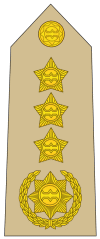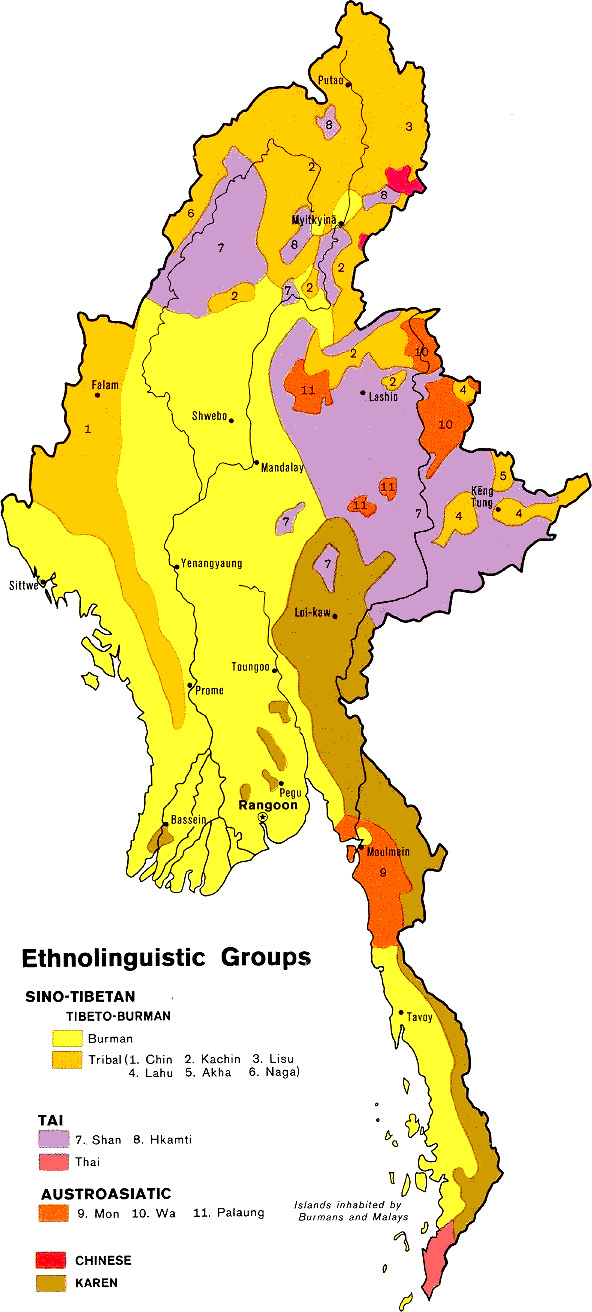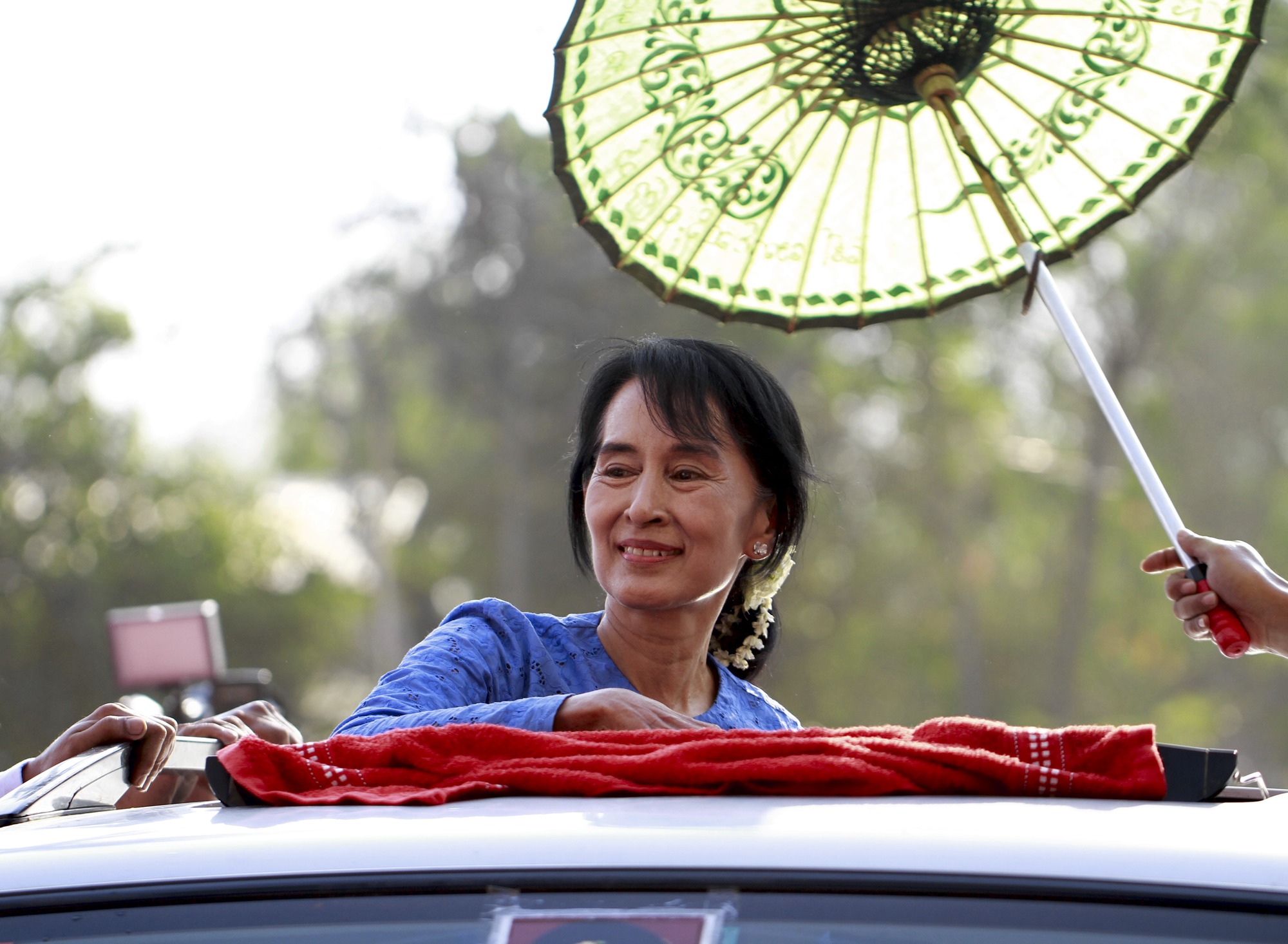|
Commander-in-chief Of Defence Services
The commander-in-chief of Defence Services () is the commanding officer of the Tatmadaw, the armed forces of Myanmar. Since a state of emergency was declared following the 2021 military coup d'état, the commander-in-chief has been the highest authority in the country, with plenary power delegated by the president and the National Defence and Security Council. According to the 2008 Constitution of Myanmar, the commander-in-chief is appointed by the president of Myanmar upon nomination by the National Defence and Security Council (NDSC), chaired by the president; the commander-in-chief is also a member of the NDSC. Article 418 of the 2008 Constitution allows the commander-in-chief broad authority over the government if the president declares a state of emergency in coordination with the NDSC. This happened after the 2021 military coup d'état: military-installed Acting President Myint Swe declared a state of emergency and transferred power to Commander-in-Chief Min Aung Hlaing, ... [...More Info...] [...Related Items...] OR: [Wikipedia] [Google] [Baidu] |
Senior General (Myanmar)
Senior general ( my, ဗိုလ်ချုပ်မှူးကြီး) is the highest rank in Myanmar Armed Forces. It is held by the Commander-in-Chief of Defence Services (CinCDS). Since 2011, a person appointed as CinCDS has to be quickly promoted one higher rank every year until he get the rank of Senior general. The rank insignia of Senior general is with a big star surrounded by a flower branch and with four small stars. Its rank medal and car insignia show that it is the five-star general rank, and the flag of CinCDS confirms it. The rank of Senior general is two ranks higher than that of a General (a full General), but in terms of stars, the Senior general has only one more star than the General. The Senior general rank exists in all branches: Myanmar Army, Myanmar Navy and Myanmar Air Force, but all these ranks are to be held by the same person at a time no matter from which branch he was promoted. A person holding the rank of Senior general can wear any uniform from ... [...More Info...] [...Related Items...] OR: [Wikipedia] [Google] [Baidu] |
Military Junta
A military junta () is a government led by a committee of military leaders. The term ''junta'' means "meeting" or "committee" and originated in the national and local junta organized by the Spanish resistance to Napoleon's invasion of Spain in 1808.Junta ''Encyclopædia Britannica'' (last updated 1998). The term is now used to refer to an characterized by |
Burma Socialist Programme Party
The Burma Socialist Programme Party (BSPP), ; abbreviated , was Burma's ruling party from 1962 to 1988 and sole legal party from 1964 to 1988. Party chairman Ne Win overthrew the country's democratically elected government in a coup d'état on 2 March 1962. For the next 26 years, the BSPP governed Burma under a totalitarian military dictatorship, until mass protests in 1988 pressured party officials to adopt a multi-party system. Founding and programme The BSPP was established on 4 July 1962, after the declaration of the "Burmese Way to Socialism" (BWS) by the Union Revolutionary Council (URC) on 30 April 1962. The BWS set out the political and economic ideology of the URC which had taken over power in the military coup of 2 March 1962. The BSPP advocated a programme of the "Burmese Way to Socialism" which, according to Ne Win, incorporated elements of Buddhism, humanism, and Marxism. The programme was described by some scholars as anti-Western and isolationist. A b ... [...More Info...] [...Related Items...] OR: [Wikipedia] [Google] [Baidu] |
Ne Win
Ne Win ( my, နေဝင်း ; 10 July 1910, or 14 or 24 May 1911 – 5 December 2002) was a Burmese politician and military commander who served as Prime Minister of Burma from 1958 to 1960 and 1962 to 1974, and also President of Burma from 1962 to 1981. Ne Win was Burma's military dictator during the Socialist Burma period of 1962 to 1988. Ne Win founded the Burma Socialist Programme Party (BSPP) and overthrew the democratic Union Parliament of U Nu in the 1962 Burmese coup d'état, establishing Burma as a one-party socialist state under the Burmese Way to Socialism ideology. Ne Win was Burma's ''de facto'' leader as chairman of the BSPP, serving in various official titles as part of his military government, and was known by his supporters as U Ne Win. His rule was characterized by a non-aligned foreign policy, isolationism, one-party rule, economic stagnation and superstition. Ne Win resigned in July 1988 in response to the 8888 Uprising that overthrew the BSPP, ... [...More Info...] [...Related Items...] OR: [Wikipedia] [Google] [Baidu] |
Karen Conflict
The Karen conflict is an armed conflict in Kayin State, Myanmar (formerly known as Karen State, Burma). It is a part of the wider internal conflict in Myanmar, the world's longest ongoing civil war. Karen nationalists have been fighting for an independent state, known as Kawthoolei, since 1949. The Karen National Union and its Karen National Liberation Army (KNLA) are the most prominent Karen rebel groups. Hundreds of thousands of civilians have been displaced through the course of the conflict, many of whom have fled to neighbouring Thailand and remain confined to refugee camps. Karen nationalists in the region also have connections with other separatist groups. Karen people The Karen people are one of the largest ethnic minorities in Myanmar with a population of 5 to 7 million. There are around twenty different Karen dialects, of which Sgaw and Pwo are the most widely spoken. The Karen languages are part of the Tibeto-Burman languages which are a branch of the Sino-Ti ... [...More Info...] [...Related Items...] OR: [Wikipedia] [Google] [Baidu] |
Karen People
The Karen, kjp, ပ်ုဖၠုံဆိုဒ်, my, ကရင်လူမျိုး, , th, กะเหรี่ยง ( ), also known as the Kayin, Kariang or Kawthoolese, are an ethnolinguistic group of Sino-Tibetan language–speaking peoples. The group as a whole is heterogeneous and disparate as many Karen ethnic groups do not associate or identify with each other culturally or linguistically. These Karen groups reside primarily in Kayin State, southern and southeastern Myanmar. The Karen, approximately five million people, account for approximately seven percent of the Burmese population. Many Karen have migrated to Thailand, having settled mostly on the Myanmar–Thailand border. A few Karen have settled in the Andaman and Nicobar Islands, India, and other Southeast Asian and East Asian countries. The Karen groups as a whole are often confused with the Padaung tribe, best known for the neck rings worn by their women, but t ... [...More Info...] [...Related Items...] OR: [Wikipedia] [Google] [Baidu] |
Smith Dun
Smith may refer to: People * Metalsmith A metalsmith or simply smith is a craftsperson fashioning useful items (for example, tools, kitchenware, tableware, jewelry, armor and weapons) out of various metals. Smithing is one of the oldest list of metalworking occupations, metalworking o ..., or simply smith, a craftsman fashioning tools or works of art out of various metals * Smith (given name) * Smith (surname), a family name originating in England, Scotland and Ireland ** List of people with surname Smith * Smith (artist) (born 1985), French visual artist Arts and entertainment * Smith (band), an American rock band 1969–1971 * Smith (EP), ''Smith'' (EP), by Tokyo Police Club, 2007 * Smith (play), ''Smith'' (play), a 1909 play by W. Somerset Maugham * Smith (1917 film), ''Smith'' (1917 film), a British silent film based on the play * Smith (1939 film), ''Smith'' (1939 film), a short film * ''Smith!'', a 1969 Disney Western film * Smith (TV series), ''Smith'' (TV series), ... [...More Info...] [...Related Items...] OR: [Wikipedia] [Google] [Baidu] |
Bo Let Ya
Bo Let Ya ( my, ဗိုလ်လက်ျာ, ; also spelt Bo Letya; born Hla Pe; 30 August 1911 – 29 November 1978) was a Burmese military officer and a member of the legendary Thirty Comrades who fought for Burma's independence from Britain. He also served as the 2nd Commander-in-chief of the Armed Forces of the Union of Burma (now Myanmar) and Deputy Prime Minister of Burma. Early life He attended Myoma High School in Rangoon. Career During the Second World War he was Chief of Staff of the Burma Defence Army (1942-1943) and as Deputy Minister of War in the Japanese puppet-state, the State of Burma (1943-1945). After the war, he replaced Aung San as Deputy Prime Minister and Defence Minister when the latter was assassinated on 19 July 1947. He was later made to resign from the post by AFPFL Government. He was involved in the 1947 Let Ya-Freeman Agreement. He also founded the Patriotic Burmese Army in 1969, an exile rebel army based in Thailand. During the 1950s and 19 ... [...More Info...] [...Related Items...] OR: [Wikipedia] [Google] [Baidu] |
Burma Independence Army
The Burma Independence Army (BIA), was a collaborationist and revolutionary army that fought for the end of British rule in Burma by assisting the Japanese in their conquest of the country in 1942 during World War II. It was the first post-colonial army in Burmese history. The BIA was formed from group known as the Thirty Comrades under the auspices of the Imperial Japanese Army after training the Burmese nationalists in 1941. The BIA's attempts at establishing a government during the invasion led to it being dissolved by the Japanese and the smaller Burma Defence Army (BDA) formed in its place. As Japan guided Burma towards nominal independence, the BDA was expanded into the Burma National Army (BNA) of the State of Burma, a puppet state under Ba Maw, in 1943.Donald M. Seekins, ''Historical Dictionary of Burma (Myanmar)'' (Scarecrow Press, 2006), 123–26 and 354. After secret contact with the British during 1944, on 27 March 1945, the BNA revolted against the Japanese. The ... [...More Info...] [...Related Items...] OR: [Wikipedia] [Google] [Baidu] |
World War II
World War II or the Second World War, often abbreviated as WWII or WW2, was a world war that lasted from 1939 to 1945. It involved the vast majority of the world's countries—including all of the great powers—forming two opposing military alliances: the Allies and the Axis powers. World War II was a total war that directly involved more than 100 million personnel from more than 30 countries. The major participants in the war threw their entire economic, industrial, and scientific capabilities behind the war effort, blurring the distinction between civilian and military resources. Aircraft played a major role in the conflict, enabling the strategic bombing of population centres and deploying the only two nuclear weapons ever used in war. World War II was by far the deadliest conflict in human history; it resulted in 70 to 85 million fatalities, mostly among civilians. Tens of millions died due to genocides (including the Holocaust), starvation, ma ... [...More Info...] [...Related Items...] OR: [Wikipedia] [Google] [Baidu] |
Aung San Suu Kyi
Aung San Suu Kyi (; ; born 19 June 1945) is a Burmese politician, diplomat, author, and a 1991 Nobel Peace Prize laureate who served as State Counsellor of Myanmar (equivalent to a prime minister) and Minister of Foreign Affairs from 2016 to 2021. She has served as the chairperson of the National League for Democracy (NLD) since 2011, having been the general secretary from 1988 to 2011. She played a vital role in Myanmar's transition from military junta to partial democracy in the 2010s. The youngest daughter of Aung San, Father of the Nation of modern-day Myanmar, and Khin Kyi, Aung San Suu Kyi was born in Rangoon, British Burma. After graduating from the University of Delhi in 1964 and St Hugh's College, Oxford in 1968, she worked at the United Nations for three years. She married Michael Aris in 1972, with whom she had two children. Aung San Suu Kyi rose to prominence in the 8888 Uprising of 8 August 1988 and became the General Secretary of the NLD, which she h ... [...More Info...] [...Related Items...] OR: [Wikipedia] [Google] [Baidu] |
Thirty Comrades
The Thirty Comrades ( my, ရဲဘော်သုံးကျိပ်) constituted the embryo of the modern Myanmar, Burmese army called the Burma Independence Army (BIA) which was formed to fight for independence from UK, Britain. This was accomplished just before the majority of the Thirty Comrades returned with the invading Japanese Army initially through Southern Myanmar, Burma in December 1941. In April 1941, small groups of Burmese youth left Burma secretly to obtain military training to fight the British Raj, British Colonists in the struggle for independence. Their leader was Thakin Aung San and they were sent by the Dobama Asiayone ("We Burmans Association") with the intention to get assistance from Guangzhou. By a quirk of fate, however, they ran into the Japanese instead in Amoy and arrived in Japan later to be flown to occupied parts of sanya, in order to receive military training by the Japanese Army. They were later moved to Formosa for security reasons and subs ... [...More Info...] [...Related Items...] OR: [Wikipedia] [Google] [Baidu] |

.jpg)






